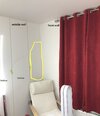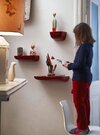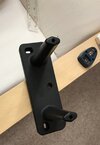I have a house built in 2016 - with mostly plaster board hollow walls.
I’m a novice at DIY, but (with a lot of googling/Youtube) I’ve successfully used ‘GripIt’ fixings to put up heavy mirrors/art on the plasterboard. I was planning to use them for the floating shelves I wanted to put up.
BUT, I’ve discovered about 40cm of the wall near corner of the lounge (where I want to put shelf brackets) doesn’t sound hollow when knocking.
It’s the outside wall of a semi. The green dotted lines in the photo are the ‘normal’ studs. The yellow scribble (~40cm wide) is the harder bit. The ~10cm nearest the corner does feel very hard, brick maybe (but I don’t need to drill/screw quite that close to the corner.)
I wondered if this stretch could be a large plank of wood (I’ve tried googling stud walls and corners, & am just overwhelmed.) Might this be the case in a relatively modern house?
And if so, am I right in understanding I can just screw the screws [that came with the shelves] directly into the wall (i.e. no drilling a hole first, no rawl plugs??)
I want to put a heavy ornament on it, & checked the limit for the shelf which said “Maximum load: 20 kg” and I’d planned to use red GripIt fixings ('up to 74kg,) so am concerned I get it right!
Any tips are appreciated. Thank you in advance.
I’m a novice at DIY, but (with a lot of googling/Youtube) I’ve successfully used ‘GripIt’ fixings to put up heavy mirrors/art on the plasterboard. I was planning to use them for the floating shelves I wanted to put up.
BUT, I’ve discovered about 40cm of the wall near corner of the lounge (where I want to put shelf brackets) doesn’t sound hollow when knocking.
It’s the outside wall of a semi. The green dotted lines in the photo are the ‘normal’ studs. The yellow scribble (~40cm wide) is the harder bit. The ~10cm nearest the corner does feel very hard, brick maybe (but I don’t need to drill/screw quite that close to the corner.)
I wondered if this stretch could be a large plank of wood (I’ve tried googling stud walls and corners, & am just overwhelmed.) Might this be the case in a relatively modern house?
And if so, am I right in understanding I can just screw the screws [that came with the shelves] directly into the wall (i.e. no drilling a hole first, no rawl plugs??)
I want to put a heavy ornament on it, & checked the limit for the shelf which said “Maximum load: 20 kg” and I’d planned to use red GripIt fixings ('up to 74kg,) so am concerned I get it right!
Any tips are appreciated. Thank you in advance.




